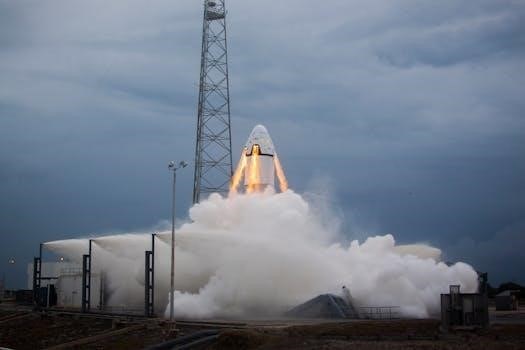
The field of space mission engineering has evolved, requiring updated resources. The New SMAD (Space Mission Engineering) provides a modern approach to both a text and a practical reference. This represents a significant shift from the original.
Overview of Space Mission Engineering
Space mission engineering encompasses the complex process of designing, developing, and implementing space missions. It integrates various disciplines, including orbital mechanics, spacecraft design, and mission operations, to achieve specific scientific or technological objectives. The field demands a systematic approach, considering all aspects from initial concept to mission completion. This includes defining mission goals, selecting appropriate technologies, managing resources, and mitigating risks. Space mission engineering also involves collaboration between diverse teams, including scientists, engineers, and program managers, each contributing their expertise to the mission’s success. The field is constantly evolving with advancements in technology and changes in mission requirements. The New SMAD addresses this evolution, providing a comprehensive framework for modern space mission engineering practices.
The Need for Updated Resources in Space Mission Design
The field of space mission design has seen significant advancements, rendering older resources obsolete. The rapid pace of technological innovation, from new materials to advanced propulsion systems, demands a contemporary approach. Furthermore, mission objectives are becoming more complex, requiring sophisticated analysis and design techniques. Traditional resources often fail to incorporate the latest developments, leaving engineers without the necessary tools and knowledge. The New SMAD addresses this critical gap by providing a comprehensive, up-to-date reference that reflects current best practices. It also integrates digital tools and resources, recognizing the shift towards electronic information sharing and collaborative work environments. This need for updated resources is crucial for ensuring the success of future space missions.
The New SMAD⁚ A Modern Approach
The New SMAD provides a contemporary perspective on space mission engineering. It serves as both a learning tool and a practical guide, reflecting advancements in the field.
Key Features of the New SMAD
The New SMAD distinguishes itself through several key features designed to enhance the user experience and provide comprehensive coverage of space mission engineering. It is structured as a unified text and reference, catering to both academic and practical engineering needs. The integration of an electronic version allows for greater accessibility and flexibility. Furthermore, downloadable Excel models provide users with tools to specialize data for specific missions. The New SMAD also incorporates the latest advancements in space technology and modern learning methods. This ensures that the material is both relevant and engaging for today’s space professionals and students. It also covers essential topics, reflecting current practices in the field.

Comparison with the Original SMAD
The New SMAD represents a significant departure from the original Space Mission Analysis and Design (SMAD) book published in 1999. While the original served the space community for many years, the New SMAD addresses the advancements in space technology and modern learning techniques. The New SMAD provides a more unified approach to text and reference materials and includes an electronic version, offering greater flexibility and accessibility. The original SMAD is considered a standard reference, while the New SMAD incorporates updated methodologies and tools to reflect the current state of space mission engineering. A key difference is the inclusion of downloadable Excel models, which were not available in the original, enabling users to tailor data to specific mission needs.
The New SMAD as a Text and Reference
The New SMAD is designed to function as both a comprehensive textbook and a practical engineering reference for space mission design. It combines the features of a traditional unified text, covering the breadth of the field, with the utility of a detailed reference guide. This dual function is intended to cater to a wide range of users, from students learning the fundamentals to experienced engineers working on complex missions. Its structure facilitates learning while providing quick access to specific information. The inclusion of an electronic version enhances its value as a reference tool, allowing for easy searchability and portability. This approach aims to meet the evolving needs of the space engineering community.
Content and Structure of the New SMAD
The New SMAD is organized into distinct parts, starting with the foundations of space mission engineering. This structure aims to guide the reader through the complexities of mission design.

Part 1⁚ Foundations of Space Mission Engineering
Part 1 of the New SMAD lays the groundwork for understanding space mission engineering. It introduces core concepts and principles essential for successful mission design. This section includes an introduction to the field, setting the stage for more advanced topics. It also delves into the various communities involved in space missions, highlighting their roles and interdependencies. This foundational knowledge is crucial before exploring the intricacies of the space mission engineering process. Furthermore, this section establishes a common understanding of terminology and methodologies. This section emphasizes the importance of a solid understanding of these fundamentals as a base for subsequent sections of the text, and serves as a starting point for anyone looking to delve into the process of space mission engineering. The first part is essential for comprehending the rest of the book.
Space Mission Communities and Their Roles
The New SMAD emphasizes the collaborative nature of space missions by dedicating a section to space mission communities. This part explores the diverse groups involved, from scientists and engineers to policymakers and support staff. Each community has a specific role in the overall mission lifecycle. Understanding the interactions and dependencies between these groups is crucial for mission success. This section details the unique contributions of each community. It also highlights the importance of effective communication and coordination. Moreover, this section emphasizes how different perspectives and expertise are essential to space missions. It is designed to help readers appreciate the complexity of space missions as a result of many communities working together. The text also provides an understanding of how these communities interact to achieve mission objectives, and how their roles affect the outcome of the mission.

The Space Mission Engineering Process
The New SMAD thoroughly outlines the space mission engineering process, detailing each phase from initial concept to mission completion. This section describes the systematic approach required for successful space missions. It explains how the process involves defining mission objectives, designing the spacecraft, and planning the mission operations. It also emphasizes the importance of systems engineering principles. The text covers various stages such as requirements definition, preliminary design, detailed design, integration, testing, and launch. This section also includes the crucial aspects of mission planning and execution. Furthermore, the importance of continuous monitoring, data analysis and adaptation during the mission is discussed. The process ensures that all elements of a mission are well-defined, coordinated, and successfully implemented. The comprehensive coverage is essential for understanding how space missions are developed and managed.
Practical Applications and Resources
The New SMAD offers practical tools like Excel models for mission specialization. It also includes system engineering tools, aiding in real-world mission design and analysis. These resources enhance practical applications.
Excel Models for Mission Specialization
A key feature of the New SMAD is its inclusion of web-based, downloadable Excel models. These models are designed to allow users to quickly and easily tailor data to specific mission requirements. This provides a practical approach to space mission design, moving beyond theoretical concepts to real-world application. The models offer a significant advantage by enabling customization of mission parameters. Users can readily adapt the data to their unique mission needs. This capability is invaluable for engineers seeking to optimize mission design based on project specifics. The availability of these models reflects the New SMAD’s commitment to practical engineering applications. It ensures that the information provided is not only theoretical but also directly applicable to mission planning and execution, allowing for efficient mission specialization.
System Engineering Tools in the New SMAD
The New SMAD emphasizes the integration of practical system engineering tools to enhance mission design. It includes complex toolsets and methodologies necessary for modern space missions. The text underscores the importance of standards in space systems development, particularly referencing the CCSDS recommendations for space data system standards, such as those for attitude data messages. These tools are intended to assist engineers in the detailed planning and execution of space missions. The focus on system engineering ensures a comprehensive approach to mission design, incorporating all relevant aspects from initial planning to final implementation. By integrating these tools, the New SMAD facilitates a more efficient and effective mission development process, allowing for a practical approach to complex problems and challenges encountered in space engineering. This is a key differentiator.

Availability and Access
The New SMAD is available in both digital and print formats. Access options include purchase through various booksellers and online platforms. Digital versions offer convenient access for modern engineers.
Digital Versions and Formats
The New SMAD is offered in several digital formats to cater to the needs of modern engineers and students. These formats include downloadable PDFs, which allow users to access the content on various devices, such as computers, tablets, and e-readers. However, some users have noted that some digital versions may consist of scanned images of the book, which can be less convenient compared to text-based PDFs. The availability of a high-quality, text-searchable digital version is something that is still sought after by some users. The goal of these digital options is to provide easy and flexible access to the wealth of information within the New SMAD, supporting both individual study and professional reference needs in the field of space mission engineering.
Where to Purchase or Access the New SMAD
The New SMAD, authored by James R. Wertz, David F. Everett, and Jeffery John Puschell, can be acquired through various channels. It is available for purchase from the Microcosm Astronautics Books website, a primary source for this publication. Additionally, online retailers like Amazon and other book distributors may stock it. For those seeking access through academic institutions, libraries at universities such as Embry-Riddle Aeronautical University’s Hunt Library may have copies available. While a digital version is often preferred, finding a high-quality, text-searchable PDF may prove challenging, as some options are scans. Always verify the source for authenticity and current pricing before making a purchase or download. The book is also sometimes found in university bookstores as it is a popular text in the field.